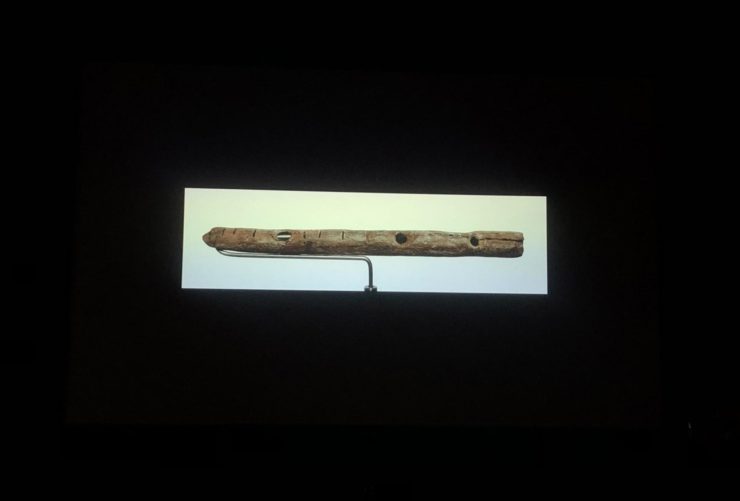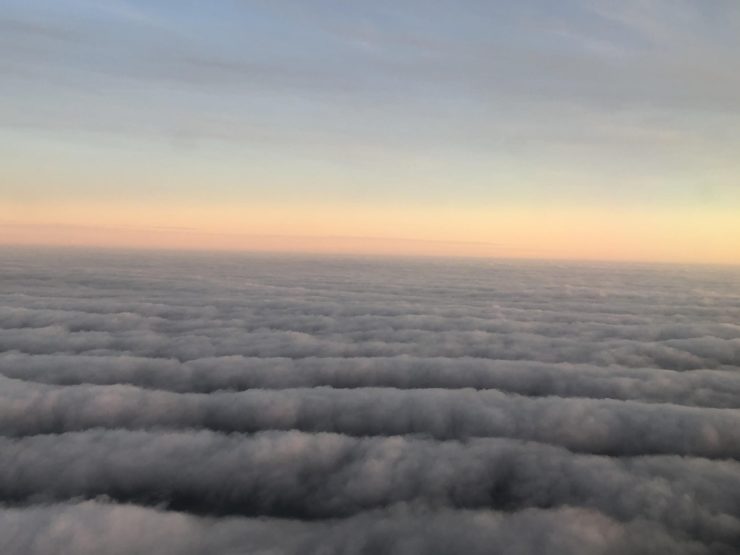Seminar Blogs
“Horizon of beats as measuring tools” – Freja Kir
This piece of writing is the first in a series of short blog posts reflecting on current perspectives for measuring transmissions in motions. The writings specifically draw on references and inspiration shared from a seminar of similar title hosted by the University of Utrecht. Throughout these written reflections my focus will be set on unpacking approaches for measuring tools, instruments, and imagination as bridge between unconventional and scientific methods.
The sound of black holes

Ancient music instrument. Slide from lecture by dr. Valery Vermeulen, captured 07.12.2019, Utrecht University, photo by Freja Kir
Imaginaries about stars, planets, and suns existed long before instruments for measuring were invented. In this objective, every astrophysical object was believed to contain vibrating relations. Though these beliefs were, later on, confirmed as light- and electromagnetic waves, such data remained abstract for conception.
Mathematics is classically connected to a rational approach. Counter wise, abstract visual language may be considered as leaning towards storytelling (Vermeulen, 2019). When bridging artistic and scientific connections between music, science, and new technologies, this post draws on a lecture by mathematician scholar and musician dr. Valery Vermeulen. Inspired by his focus on linking astrophysics with sounds, this piece of writing orbits around general considerations of artistic methods as tools for detecting scientific research in motion.
Captured as ungraspable numbers, the experiments presented by Vermeulen suggest a format for grasping such scales as sound transformed into “music of the spheres”. By sampling, chopping, and composing thematic compositions this transformation between numbers, data visualization, and sound enable direct connection between the mathematics of planetary data and sound material (Vermeulen, 2019). While this journey leads to the latest evolutions of astrophysics and how they bend the boundaries of human scientific and artistic imagination, this also begs consideration of these unconventional tools as transformations for narration.
Tools for visualization

Cloud horizon, 22.12.2019, photo by Freja Kir
When large quantities of matter gather in a tiny space this may take the form of a black hole. While theories of lightwaves between objects were imagined already in the Greek Antiquity, it was not until tools for measuring lightwaves and vibration in the 20th century, that such waves were detected. Such scales need instruments for measuring and frameworks for visualizing the quantity at stake. Tools for this purpose fall in line with a long tradition of human-produced instruments for visualizing surroundings. While this might include obvious instruments such as the camera, the satellite, or the drone, more conceptual approaches for visualization may also include the perspective or even the horizon (Steyerl, 2015). Naturally, all of these inventions are made to serve the purpose of measuring our surroundings.
When no light escapes the structure of black holes their visual presence remains invisible. Only when applying technologies researchers can trace the energy of black holes. This detour around the galaxy serves the attention of bridging the boundaries of academic and artistic imagination for the instrumental purpose of understanding something through another (Barad, 2003). When Vermeulen addresses measuring tools for grasping astrophysical numbers, such an approach may also be relevant to consider in relation to other tools for capturing our surroundings. With this outline in mind, it is tempting to consider the horizon as well as the black hole as metaphors and tools for understanding.
References:
- Steyerl, Hito. 2011. “In Free Fall: A Thought Experiment on Vertical Perspective”. e-flux journal . no 24 (April). https://www.e-flux.com/journal/24/67860/in-free-fall-a-thought-experiment-on-vertical-perspective/.
- Barad, Karen. 2003. “Posthumanist Performativity: Toward an Understanding of How Matter Comes to Matter“. Signs: Journal of Women in Culture and Society. vol. 28, no. 3 (Spring): 801-31.
Image:
- Slide from lecture by dr. Valery Vermeulen, 07.12.2019, Utrecht University, photo by Freja Kir
- Cloud horizon, 22.12.2019, photo by Freja Kir

